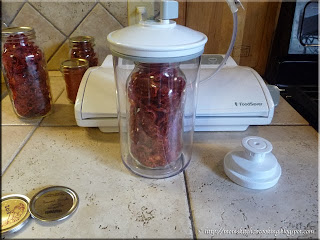This past busy processing season, I did a bit more dehydrating than I normally do using my Nesco dehydrator. Dehydrating is a very easy and inexpensive way to stock your pantry with little effort. Not only that, dried foods take up less space in the pantry than the same amount of food home canned or frozen. Like home canned foods, there is no further cost for storage. Unlike home canned and frozen foods, dried foods are light weight, easily transported if need be. Dehydrating foods need not be restriction to in season crops either as it is an excellent way to take advantage of produce sales anytime of the year.
Dried foods are best vacuum sealed to prevent loss due to insects or moisture. I like vacuum sealing dried foods in mason jars because the glass also protects against loss due to rodents. An alternative method I have used is to vacuum seal dry foods in the plastic bagging material then place the packets in rodent-proof containers.
I use either a standard mouth vacuum sealer adapter (pictured) or a wide mouth adapter (not pictured) depending on the style of mason jar I'm using. I also reuse the metal snap lids that were originally used for home canning. These lids cannot be reused for home canning but they are still usable for vacuum sealing providing they are not damaged. I label home canned foods directly on the lid using a Sharpie marker. I do not remove any writing on used lids until after they have been vacuum sealed. Normally, the lids seal without a problem although occasionally I need to use the two lid method to get a good seal. For some reason, one of the lids did not want to seal. I was using older Bernardin jars so the shoulder could have been the problem. At any rate, I resorted to another trick for vacuum sealing lids by placing the filled jar with lid in a vacuum sealer canister.
Then I placed the lid on the canister and attached the hose as I normally would. Essentially with this method a larger volume of air is removed but in the end the jar seals. This method works nicely for any mason jar with higher shoulders that prevents the adapter from seating properly. It can also be used for any mason jar in lieu of the adapter. An adapter costs about $10 for the standard mouth size while the wide mouth size is a bit more and can be difficult to find. Canisters are a bit easier to find locally even appearing in thrift stores occasionally. eBay is another inexpensive source for vacuum sealer canisters as well. Once the vacuum sealer stops, I simply released the vacuum on the canister and removed the vacuum sealed jar.
As pictured, the jar vacuum sealed nicely using the canister method. There was a noticeable indent in the centre of the lid indicating a good vacuum seal. At this point, the only thing left to do was clean the marker off the lid then relabel for storage.
As mentioned, I like using a Sharpie marker for labeling just about anything in the pantry or freezers. It can be used on just about any surface although may not clean off porous surfaces well. It can also leave ghost marks on some plastics. The marker comes off easily from metal, glass and some plastics with rubbing alcohol.
In total, I dried two quart jars and one pint jar of tomato slices as well as enough to make a half-pint of tomato powder. Each quart jar holds the amount of tomato slices I dried per load in the dehydrator using 6 trays. The tomato powder is the equivalent of 2 quart jars of tomato slices or a total of 12 trays of dried tomato slices. You may be wondering why I left some of the tomato slices as is rather than powder all of them. The main reason is flavour. I only powder the amount I will use within a reasonable amount of time then powder more as needed. The second reason is versatility since the dried tomato slices can be used as an ingredient in dips and soups.
Tomato powder is a must have in any pantry! It can be used to make tomato paste or sauce, add extra flavour to soups, stews and meatloaf, or sprinkled on salad or other vegetables as a seasoning. Commercially prepared tomato powder is available but it is expensive at as much as $1.10 per ounce or more. It is not a product that I can find locally, so for me as well as many, tomato powder is a product that would have to be ordered online or by mail order. Homemade tomato powder can be as inexpensive as only the power it takes to run the dehydrator (my case) or the price of about 30 large paste tomatoes. Even buying the tomatoes and making your own tomato powder will still realize a savings. I used paste tomatoes because that is what I had. Any tomato can be used to make tomato powder although I highly recommend using organic tomatoes. Cherry tomatoes make a wonderful tomato powder if you find a good deal on them. Mixing tomato varieties works well too making this an ideal way to use up excess tomatoes from the garden.









0 food lovers commented:
Post a Comment